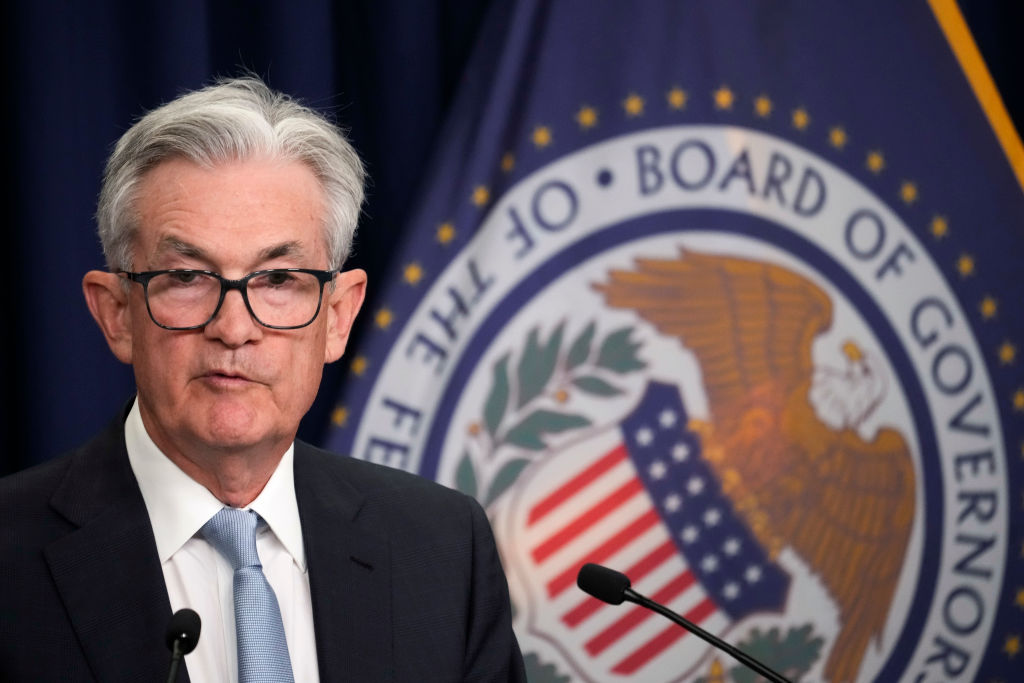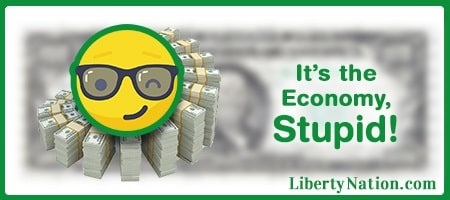
WASHINGTON, DC – JUNE 15: U.S. Federal Reserve Board Chairman Jerome Powell speaks during a news conference following a meeting of the Federal Open Market Committee (FOMC) at the headquarters of the Federal Reserve on June 15, 2022 in Washington, DC. Powell announced that the Federal Reserve is raising interest rates by three-quarters of a percentage point, the highest rate hike in 28 years. (Photo by Drew Angerer/Getty Images)
What was supposed to be a controlled fire has metastasized into an inferno inside the Eccles Building. Much like insisting for nearly a year that inflation would be transitory, the men and women in Washington convinced the public that only a modest round of monetary policy tightening would be necessary to put the kibosh on 40-year inflation. Can the Federal Reserve remain calm as the five-alarm fire burns everything to ash, or will Jerome Powell and his colleagues panic and pull the trigger on substantial rate increases? The Fed already hopped on a time machine to travel back to 1994, so anything is possible with this graduating class of misfits.
Pump Up the Interest Rates
 Following its two-day policy meeting, the Federal Open Market Committee (FOMC) voted to raise the benchmark federal funds rate by 75 basis points, the biggest increase since November 1994 and higher than the 50 basis points that the rate-setting committee had pledged just a month earlier. The target rate is now in the vicinity of 1.75% and 2%, the highest it has been since before the coronavirus pandemic. Although Fed Chair Jerome Powell told reporters during the post-FOMC news conference that he does not anticipate three-quarter-point rate hikes would be the new normal, the phrase “fool me once, fool me twice” rings true.
Following its two-day policy meeting, the Federal Open Market Committee (FOMC) voted to raise the benchmark federal funds rate by 75 basis points, the biggest increase since November 1994 and higher than the 50 basis points that the rate-setting committee had pledged just a month earlier. The target rate is now in the vicinity of 1.75% and 2%, the highest it has been since before the coronavirus pandemic. Although Fed Chair Jerome Powell told reporters during the post-FOMC news conference that he does not anticipate three-quarter-point rate hikes would be the new normal, the phrase “fool me once, fool me twice” rings true.
The June FOMC powwow was a compelling meeting for other reasons, too. Indeed, a few things stood out: policymakers anticipate the economy to slow down, the Fed forecasts that rates will be above 3% by the end of 2022, and the central bank already intends to cut interest rates in 2024. Powell also noted that he thinks it is possible the Eccles Building can navigate a soft landing.
The FOMC said in a statement:
“Overall economic activity appears to have picked up after edging down in the first quarter. Job gains have been robust in recent months, and the unemployment rate has remained low. Inflation remains elevated, reflecting supply and demand imbalances related to the pandemic, higher energy prices, and broader price pressures.
“The invasion of Ukraine by Russia is causing tremendous human and economic hardship. The invasion and related events are creating additional upward pressure on inflation and are weighing on global economic activity. In addition, COVID-related lockdowns in China are likely to exacerbate supply chain disruptions. The Committee is highly attentive to inflation risks.”

Looking ahead to the next FOMC get-together, the US futures rate market is penciling in a 93% chance that the Fed will repeat this maneuver and employ a 75-basis-point increase. Powell conceded that the July meeting could come down to either 50 or 75 basis points. Investors are also keeping an eye on what could happen in September: a pause in the tightening cycle, a notable half-point jump, or a tepid quarter-point boost that was originally planned.
Too Little Too Late
Powell and his merry band of central bankers might as well throw in the towel. They have lost control of inflation. The Federal Reserve responded too late, and now it is way behind the curve, especially if the consumer price index (CPI) remains elevated at around 8.6% in June or tops the critical 9% level. What Powell could do is channel the spirit of former Fed Chair Paul Volcker and take inflation seriously by executing triple-digit rate hikes rather than inconsequential 25-, 50-, and even 75-basis-point adjustments in the benchmark rate. Even after the Fed’s hawkish turn on a path toward 3% neutrality, the real interest rate (adjusted for inflation) is still deep into negative territory.

Federal Reserve Board Chairman Jerome Powell (Photo by Drew Angerer/Getty Images)
Of course, the Fed does not want to rip the band-aid off because it would crash the already crashing financial markets and instantly trigger a recession and financial crisis. But the US could presently be sauntering into an economic downturn, which has become the baseline scenario for many market analysts and financial institutions in recent weeks. The only debate now is how long a recession would last, how severe, and when it would begin – some economists think the US is already in one.
The Atlanta Fed Bank’s GDPNow model estimate was lowered once again to 0% for the second quarter. After the first quarter’s surprise 1.5% contraction, the bearish case might be proving that the yield curve inversion, which happened for the third time this year (two-year/ten-year and five-year/20-year), is still a reliable recession indicator. The only thing that might cushion the impact of a recession is the red-hot labor market, endorsing the idea that this is an abnormal economy and millions of Americans will endure a strange type of downturn.
Prepare for Landing
At this stage of the economic cycle, it is almost impossible for Powell to steer the plane through all this turbulence and pilot the country to a soft landing. Inflation is soaring, higher rates will apply financial pain to the poor and middle-class, and the $9 trillion balance sheet run-off will have a significant impact on the equities arena. Northern Trust economists might have said it best: “If Powell can engineer a soft landing after helping to manage through the pandemic, a spot on the Federal Reserve’s Mount Rushmore may be in order.” Or, better yet, perhaps it is time to simply end the Fed.
Remember to check out the web’s best conservative news aggregator
Whatfinger.com — the #1 Alternative to the Drudge

